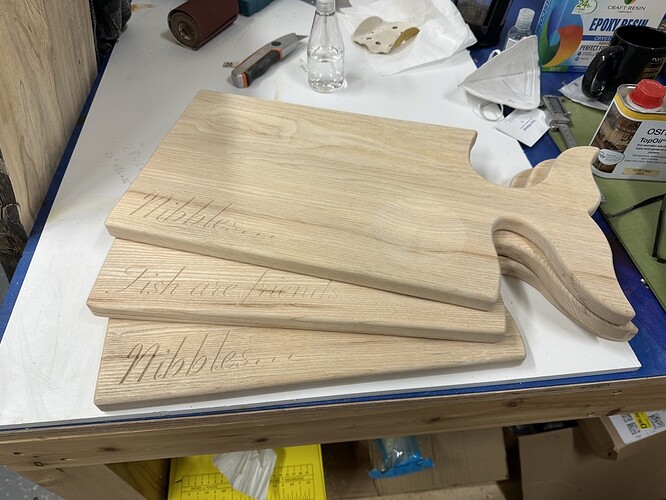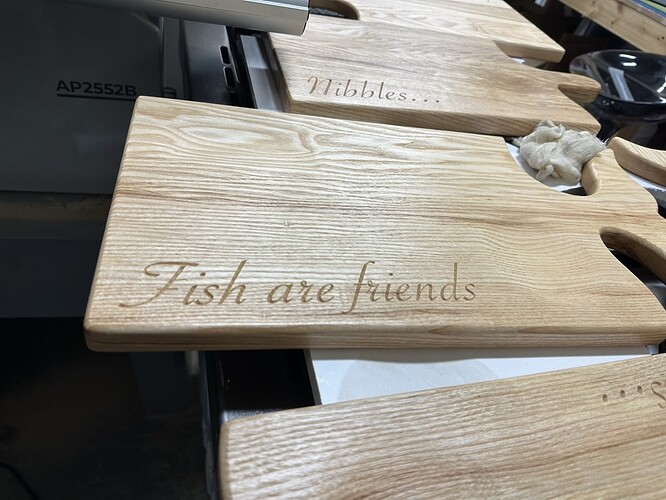Hi Team, I’ve made some acacia end grain charcuterie boards for family. I have applied multiple coats of Walrus Oil Cutting Board oil, which this wood is drinking up! Is there a recommended method for sealing the boards once the oil has “dried”? Beeswax? Any / all recommendations appreciated.
David, the oil is the finish. Reapply as needed. ![]()
Walrus cutting board oil will never actually dry. It will need to be reapplied every once in a while.
I prefer tung oil for cutting boards and food safe stuff. Tung oil eventually will dry.
I try to keep my cutting boards vegan friendly as it opens up another niche market. I use organic coconut oil and finish with an organic cutting board wax (ricebran wax, coconut oil and essential oil).
This. You can buff it a day or so after oiling.
I like to use:
I apply it to my cutting boards and then add some heat to melt the wax into the board. It seems to last longer than just using mineral oil.
For serving boards, I have had good success with Odie’s Oil. It applies as a paste, bu hardens into a durable protective layer. I used it on a wooden sink that gets used multiple times daily, and it’s holding up great.
Wooden sink? That’s interesting.
Be careful with organic oils that are vegetable based They can turn rancid over time. Mineral based oils will not turn rancid. You are on the right track but end grain is made up of straws that feed the tree when growing. Eventually the straws will fill up. Over apply your walrus oil and as others suggested the beeswax or other was based will top it off.
Make sure you tell the recipients not to put those cutting boards in the dish washer. Nothing destroys a cutting board faster than a trip through the dishwasher. The hot water and drying cycle will warp and crack a cutting board. Hand wash only. Maybe give them some of the walrus oil to renew the surface. or as @SDGuy suggested the butcher block conditioner along with the cutting board.
wood butter, made from 1:8 bees’ wax / oil ( I take vegetable oil, may be something personal: I just don’t want mineral something near the food), some drops essential oil (lemon, orange…)
If you get all local -pear oil smells nice- IMO that is affordable.
What constitutes “vegetable” oil? Most of these types of oil are manufactured in some strange ways that are now studied and shown to be unhealthy. In other words, a marketing trick. Some research will make that clear.
Mineral oil has a few mysteries in itself, but I don’t like the longevity of that as a finish.
Now you’re talkin’! ![]() I’ve been making this “butter” (based on a suggestion / formula from a smart fellow on the Vectric forum) with “Special Linseed Oil” / bees wax ratio of 80% / 20% (although I reduce the wax in the ratio on occasion.) Yes, it goes on fairly hot.
I’ve been making this “butter” (based on a suggestion / formula from a smart fellow on the Vectric forum) with “Special Linseed Oil” / bees wax ratio of 80% / 20% (although I reduce the wax in the ratio on occasion.) Yes, it goes on fairly hot.
The true linseed oil gets further into the surface and is food safe after it “dries”. The whole project can be buffed many times before it needs resurfacing.
If you need a formula for “Board Butter”, here’s mine: 3 qts mineral oil, 1 lb beeswax and 1/3 lb carnuba wax all together in a slow cooker. Carnauba wax (180*) has a higher melting temperature so it stiffens the wax and also leaves a little shine. I’ve tried just oil & beeswax (145*) 4/1 and 3/1 and it’s too soft. I apply the wax after soaking in mineral oil. All boards then sit on a rack and drip dry for 4+ hours. Each customer gets a tin of wax with washing, drying, and storage instructions with their new board. Note, the stiffer wax is especially good for shipping. Food based oils WILL turn rancid after time. Find youself a bee-keeper and buy wax from them, as the stuff sold on Amazon is not from the US.
I bought my wife a new crock pot for Christmas. Maybe this is a use for the old one.
According to the manufacturer, “Walrus cutting board oil” includes beeswax, mineral oil and coconut oil.
I suspect the coconut oil used is actually so-called “fractionated coconut oil”, making it shelf-stable.
Bottom line: WCBO is the finish. Top-coating with any other oil/wax is redundant.
-Mark
I did a batch of boards in Ash for my daughters last Christmas and finished them in Osmo Top oil and was pleased to see for a year of use. With strict instructions of no dishwasher they looked good still a year later.
For my own use I wipe my boards down and a couple of times a year use Walnut oil I have not had any issues over the years with it going rancid and I believe its one of the natural oils that will actually dry.
I used to mix my own, before many of the commercial connotations were available. Use bees wax, paraffin wax, olive oil and paint thinner.
1 pound of bees wax (Melts at 145 degrees F)
1/4# paraffin wax ( candle wax) (melts at 115-154 F)
Olive oil ( virgin or non-virgin ) 2-4 oz to be used to finalize the consistency
Paint Thinner ( Just plain paint thinner, the old clear type of thin petroleum. 4 oz
On a hot plate with a suitable thermometer not on the stove and away from flammable materials in your shop.
- in a quart pan add the bees wax and begin melting under low heat while stirring ( temp 155 F-200 F )
- When melted, add the paraffin and allow to melt.
- When completely melted, slowly add the olive oil 2 oz
- Remove from heat , stir consistently while it cools it will thicken -
- Add paint Thinner 2-4 oz , continue to stir.based on thickness, more added if too thick
- Upon cooling to room temperature, if thickness is too thick, use Paint thinner to get to a soft gel
- Upon cooling store in air tight jar or Tupperware
- To use, it should go on smoothly and coat and seal the surface without excessive rubbing. The pain solvent will evaporate leaving a sealed and water repellent finish that is non - toxic. . To achieve a hand rubbed finish use this rub, buff by hand then spray with silicone furniture polish ( pledge) and use a power buffer for a higher shine. Tom
This topic was automatically closed after 30 days. New replies are no longer allowed.

